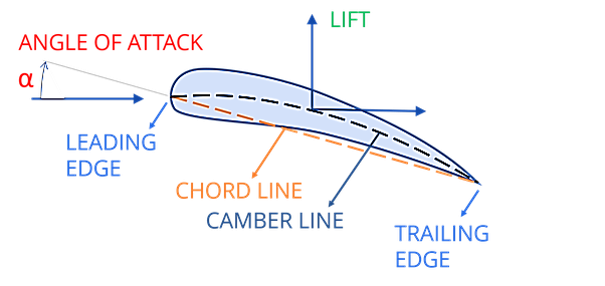
In a U.S. Air Force “spin prevention” maneuver, all the steps of a spin entry were carried out up to the point where after one turn, the airplane seemingly paused before entering a fully developed spin. The recovery from this point was to bring the stick just forward of neutral and let the wing fly again. This usually resulted in a somewhat wobbly, but slow, rotation, sometimes rolling through inverted before actually winding up straight and level.
The point to be learned was that the wing was “flying.” It had been brought back down below its critical or stall angle-of-attack. You could counter rolling tendencies, as airspeed allowed, with the ailerons and continue to work your way out of the spin situation before it developed.
The old major I flew with took great pride in keeping the checklist in place on the glareshield throughout this maneuver:
“You don’t have to be rough with it, just use enough forward pressure to barely keep that checklist there and you’re flying. Be gentle with the controls, keep the G loading very light and hang on. The plane will fly out of the situation almost by itself.”
I think there would be a discussion today about “keep that checklist there.” After all, we want a positive recovery, and, as I’ve written before, that requires the pilot to ease the stick forward until he or she just becomes aware of the seat belt, or is in zero G state. Zero G means no lift, no stall angle of attack, no stall.
The writers of the Airman Certification Standards (ACS) for private and commercial pilots lump power-on stalls, secondary stalls, accelerated stalls, elevator trim stalls and cross-control stalls together. They should. In fact, for my money, they should have thrown power-off stalls in the same header. Why? Because all stalls are created “equally.”
They happen by, and only by, exceedance of the stall angle of attack. There is a logical interconnect between a power-off stall and the rest of the mentioned events. Each one of them adds another complication to the mix, but each one is a stall preceded by something different.
A good way to introduce new pilots to stalls is to brief that “I’m going to demonstrate a number of different ways to bring on a stall. For the demo I will use no power when I recover.” While power is essential to the completion of a safe stall recovery, I want to demonstrate that it is not essential to the basic problem, breaking the stall. Therefore, for my initial demonstration, I take power out of the scenario and only talk about the wing stalling.
Clear the area. The nose comes up, at idle, the horn goes off and the airplane stalls. We ease the yoke forward and it recovers; I ease the yoke back and it stalls again (secondary); ease the yoke forward and recover; ease back up and manhandle it just a little at the end; accelerated stall; ease yoke forward; recovered; ease in power and trim; relax hold on yoke; elevator stall; yoke forward; power off; trim nose down; nose back up again; and feed in the left rudder. When it breaks, again ease the yoke forward and we’re flying.
This is actually a very gentle demonstration. I do not let the student practice this, because I want them thinking about getting power in, but I do want to demonstrate that stalls are recovered from very easily by easing the yoke forward. I have them put their hand on the yoke. Each time the airplane stalls, I make the statement “Stall,” then move the yoke a small amount and state “2 in. forward, no stall,” then repeat.
You cannot be out of control if the wing is flying. The airplane may “flop” over, even roll and aim at the ground as it seeks equilibrium through its inherent stability. You can still crash if you started too low, but the wing will be flying and it’s your only chance for recovery.
After practicing this, we discuss the setup for a real cross-control stall. In trying to make a left turn to final, the airplane overshoots. As it is overshooting, the pilot adds bottom rudder in an effort to bring the airplane around to the runway. Doing this causes yaw, which causes the left wing to drop. As the wing drops, “Stall.” Yoke “2 in. forward, recovery.”
Recovery from the cross-control stall is today’s version of the “spin prevention” I learned so long ago over the plains near Lubbock, Texas.
A spin is basically a screwup of the cross-control stall. The pilot increases back pressure. Stall. Rollover begins. If the cross-control stall recovery had not been mastered, the pilot instinctively pulls farther back. The rollover continues. Once the wing has gone beyond 90 deg. in the traffic pattern, the show is pretty much over.
Pertaining to spins, applicants for private and commercial licenses must merely be aware of the relationship between angle of attack, airspeed, load factor, power setting, airplane weight and center of gravity, airplane attitude and yaw effects. They also should be aware of what causes a spin and how to identify the entry, incipient and developed phases of a spin—and finally, how to recover.
Under risk management the applicant must demonstrate the ability to identify, assess and mitigate risks encompassing situations that could lead to spin and loss of control, range and limitation of stall warning, improper recovery procedures, the effect of environmental elements on airplane performance, turbulence microbursts, and high density altitude, collision hazards, and distractions that could lead to a spin.
The ACSs for private and commercial pilots do not require that the examinee perform a spin. I can see the logic in that, but I do believe a spin should be demonstrated to these students.
Although private and commercial applicants only have to discuss spins, the still extant Practical Test Standards (PTS) for CFIs require that spin entry, spin and spin recovery be demonstrated by the instructor and repeated in both directions by the CFI applicant:
(1) Apply the entry procedure for a power-off stall. As the airplane approaches a stall, smoothly apply full rudder in the direction of desired spin rotation and continue to apply back elevator to the limit of travel. The ailerons should be neutral.
(2) Allow the spin to develop, and be fully recovered no later than one full turn. Observe the airspeed indicator during the spin and subsequent recovery to ensure that it does not reach the red-line (VNE).
(3) Follow the recovery procedures recommended by the manufacturer in the Airplane Flight Manual or Pilot’s Operating Handbook.
“Incipient spins should be practiced to train the instructor applicant to recover from a student's poorly performed stall or unusual attitude that could lead to a spin.” This is where I fall away from the concept that a private and commercial applicant doesn’t need to at least have spins demonstrated. If it is assumed that students can put instructors into a spin when practicing, why is it not assumed that they could put themselves into one while solo?
Nevertheless, the great value of the cross-control stall practice is that the recovery procedure is started at the critical point when the angle of attack first goes beyond stall and airplane control is lost. Even though the roll-off can be violent, a new pilot, well trained in cross-controlled stall recovery, will instinctively move the yoke forward, breaking the stall and the spin entry before a spin can develop.
In summary, all spins are created equally—that is, out of a stall with yaw. All stalls are created equally by exceedance of the stall angle-of-attack. Teach private and commercial pilots to stop the potential loss of control at the stall. Drill that in over and over.
Editor’s note: This is the second of a two-part article. The first part focused on stalls.






Comments